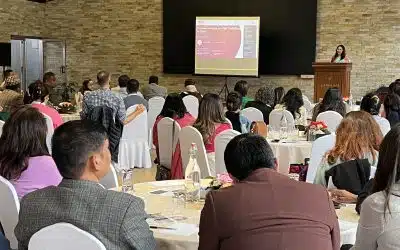The Asia Foundation Releases New Report on Armed Conflict, Aid, and Development in Myanmar
The year-long study analyzes roots and patterns of armed conflict in Myanmar, development trends in conflict-affected areas, and impact of foreign aid on conflict and peacebuilding
Washington, DC, October 17, 2017 — 
The year-long study, The Contested Areas of Myanmar: Subnational Conflict, Aid, and Development, comes at a pivotal moment amid longstanding conflicts in many parts of Myanmar, political dialogue to address the concerns of numerous ethnic groups, and a desire among international donors and aid agencies to support the peacebuilding process and the country’s political transition.
Findings from the study shed light on structural changes that are crucial for achieving sustainable and comprehensive peace in a country of great ethnic and cultural diversity. In addition, it reveals the intimate connections between subnational conflicts and national politics in Myanmar, instances where development interventions have contributed to uneven power dynamics and fueled armed resistance, and ways in which international aid can sometimes damage prospects for peace when initiatives are not sensitive to conflict. In this context, the study underscores a critical need to continue the ongoing political and economic reforms while building a system of government that is widely recognized as legitimate by people of all ethnic nationalities.
“As Myanmar emerges from decades of authoritarianism, armed conflicts, and entrenched poverty, the ongoing reforms and peace process in the country are inherently linked. Understanding how different forms of development assistance interact with conflict and governance dynamics on the ground remains crucial to assess prospects for peace in a rapidly transforming nation,” said Dr. Kim Ninh, The Asia Foundation’s country representative in Myanmar. “We hope the findings can contribute to the ongoing dialogue on development and conflict as part of Myanmar’s ongoing historic transition.”
Supported by the World Bank through the Korean Trust Fund for Economic and Peace-building Transitions, this study is part of the extensive and rigorous research the Foundation has been carrying out to help further discussions within and among government, civil society, ethnic armed groups, and development partners on how they can support development and peace.
Among the key findings of the study are the following:
Myanmar’s subnational conflicts are not a peripheral issue and directly affect much of the country
In 2016, areas affected by active or latent subnational conflict were found in at least 11 of Myanmar’s 14 states and regions. One hundred and eighteen of 330 townships, containing almost one-quarter of Myanmar’s population, currently demonstrate live or latent characteristics of conflict.
Myanmar’s conflicts are not caused by underdevelopment
There is no simple correlation between human development, economic growth, and conflict in Myanmar, and subnational conflicts will not be resolved by measures to improve development outcomes. Conflict townships are on average only marginally less developed than non-conflict townships, particularly when Yangon is excluded. Some conflict townships exceed national averages, while others have the lowest development indicators in the country.
Tackling underdevelopment alone will not create peace
Development interventions alone can never lead to peace. Myanmar’s conflicts are inherently political and connect to the structure of the state. Political solutions are, therefore, required to solve subnational conflict. Given the complex nature of Myanmar’s armed conflicts, interventions and policies should be strengthened to address the underlying drivers of conflict and be more responsive to the power inequities that have driven conflict over years, especially during transitional political periods.
Development policies can drive subnational conflict
In many contested areas, economic changes and increased natural resource exploitation have ratcheted up tensions, engendered rivalries, fueled grievances, and provided funds that have sustained conflict. Foreign assistance can sometimes be manipulated to serve security objectives, particularly where government officials or leaders of ethnic armed organizations are able to decide project locations. In short, development interventions are never neutral.
Aid can build momentum for peace as well as damage the prospects for peace
Projects that serve the security aims of one side can damage the confidence of ethnic groups in the country’s transition, while programs that support political reforms, such as decentralization, can help build momentum. USD 13.7 billion in aid was committed to new projects between 2011 and 2015. Closer alignment of donors with government offers advantages in coverage, cost effectiveness, and sustainability, but it also poses risks for peace.
“The report presents a well-researched body of work that offers crucial inputs for policymakers, donors, and peace process stakeholders. It tackles important questions concerning how aid can negatively affect conflict and positive ways development and aid can help to contribute towards building peace”, said Dr. Sai Oo, country representative of Pyidaungsu Institute for Peace and Dialogue in Yangon, Myanmar, and a member of the Union Peace Dialogue Joint Committee (UPDJC).
The Asia Foundation in Myanmar
The Asia Foundation is a nonprofit international development organization committed to improving lives across a dynamic and developing Asia. In 2013, the Foundation re-established a resident country office in Myanmar after an absence of more than 50 years. The Foundation works with partners in government, the private sector, and civil society to build the country’s capacity for regional and global integration, strengthen the core institutions and processes of democratic governance at national and local levels, support initiatives for inclusive economic development, promote women’s empowerment and political participation, and increase public access to information through policy research and dissemination. The Foundation’s Books for Asia program has operated in Myanmar since 2007.
Read more about the Foundation’s work.
For media inquiries, please visit our News Room. Engage with us on Facebook, Twitter, and Instagram.
Read our latest news, or insights from our blog.
Media contact
Eelynn Sim, Director, Strategy and Programs
[email protected]
The Latest Across Asia
News
April 2, 2024
Program Snapshot
March 28, 2024
Program Snapshot
March 28, 2024
Program Snapshot
March 25, 2024

2024 Lotus Leadership Awards
Thursday, April 25, 2024, New York City
The Lotus Leadership Awards recognize contributions towards gender equality in Asia and the Pacific






